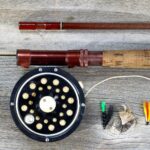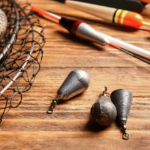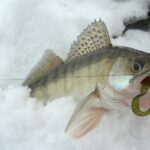Nothing is more irritating or dampening than getting snagged when you want to enjoy a relaxing fishing trip. While you can choose a spot with less grass in the water, other obstacles like branches and old fishing lines will still exist. It’s vital to know which sinkers are the best to prevent getting snagged.
Overall, the egg sinker is the best choice since it flows freely through the water. Still, there are many other options you can also consider. For example, the tungsten, bullet, and bank sinkers will also enable you to fish better and help you avoid snags.
Sinkers are used as weights to get your bait or hook down into deeper water, and they can come in many different shapes and styles. Many people must realize how important a sinker is to your fishing line.
The Simple And Plain Egg Sinker

Egg sinkers are the best option for avoiding snags and are also great for live bait. The egg sinkers are smooth and round, with a hole passing through the middle for the fishing line. The design of these sinkers will allow it to flow freely through the water, minimizing the risk of snags. You can also use these sinkers in various freshwater and saltwater fishing techniques, such as bottom fishing, trolling, and drifting.
The weight of an egg sinker can vary between a few grams up to a couple of ounces, which means you can choose the appropriate weight for the water depth, current, and size of the fish you want to catch. In addition, they allow your bait to reach the desired depth while minimizing snags by rolling over obstacles such as rocks, weeds, and other underwater obstructions.
However, egg sinkers do have some downsides, like their casting distance. Egg sinkers might have a different throwing range than bullet sinkers, which are more streamlined. Their round shape can make them less aerodynamic than other choices. They can also make it more challenging to detect bites since they are less sensitive.
If you use the egg sinker, you are more likely to catch the following types of fish:
- Sea Bream
- Flounder
- Surf Perch
- Bass
Ideal terrain to use egg sinkers:
- Rough grounds
- Rocky structures
- Grassy areas
The Slim Bullet Sinker


The appearance of bullet sinkers closely resembles their name. The streamlined shape enables them to cut through the water, thus minimizing the likelihood of snags. Fishermen mostly use these sinkers for bass fishing. With these sinkers, you will reduce the chances of snagging on grass, rocks, and other structures under the water. In addition, they work well on rigs such as Carolina, Texas, and Drop-Shot rigs.
The improved sensitivity on the bullet sinkers will allow for better transmission and vibrations along the fishing line. This sensitivity will enable you to detect even the most subtle bites on your line. Bullet sinkers are excellent in providing bottom-holding power. The sinker’s pointed end sinks into the bottom substrate, securing your bait or lures even in moderate to strong currents.
Bullet sinkers don’t have great casting in windy weather since the shape’s increased surface area makes it less aerodynamic. As a result, you might need to adjust your casting technique in these conditions. The pointed ends of the sinkers can also cause line twisting while retrieving the line, leading to knots, tangles, and additional time wasted.
If you use the bullet sinker, you are more likely to catch the following types of fish:
- Bass
- Catfish
Ideal terrain to use bullet sinkers:
- Swift water flow areas
- Rocky areas
- Grassy areas
The Versatile Slip Sinker

Slip or sliding sinker designs allow them to slide freely along the fishing line. They have a hole through which the line can pass, allowing the sinker to move without restrictions. These sinkers are versatile, and you can use them in plenty of places and fishing techniques, including bottom fishing, slip bobber fishing, and Carolina rig fishing.
One of the best things about this sinker is the adjustable fishing depth, allowing you to adjust the depth of your bait with a stopper or bobber. You can also easily rig the slip sinkers since their setup is straightforward and quick.
Line twisting can occur during casting and retrieval using slip sinkers because of their sliding construction, which is one of the greatest drawbacks. In addition, you may need accessories like stoppers or bobber stops to keep your slip sinkers in place as you fish. While these parts are straightforward to install, they require precise adjustment to prevent unwanted sliding or loosening during rigging.
If you use the slip sinker, you are more likely to catch the following types of fish:
- Catfish
- Trout
- Bass
- Walleye
Ideal terrain to use slip sinkers:
- Areas with vegetation
- Rocky terrain
The Practical Bank Sinker

Bank sinkers are bell-shaped and have flat sides to reduce the chances of getting snagged with their low profile. You can mostly use them for keeping your bait in one place without much movement. They will lie flat on the bottom of the lake and, therefore, won’t be disturbed by the currents.
Bank sinkers are essential when bottom fishing or offering bait near the lake or riverbank. Still, fishing, surf fishing, and catfishing are just some of the bottom fishing techniques that benefit from their versatility. These sinkers are easy to rig and have many weight options.
However, these bank sinkers have a limited casting distance and a reduced sensitivity which can hinder your fishing performance. Because bank sinkers are flat, they can sometimes disturb the bottom when cast or pulled up. This disturbance can stir up sediment, making the water less clear and scaring away fish.
If you use the bank sinker, you are more likely to catch the following types of fish:
- Flounder
- River fish
Ideal terrain to use bank sinkers:
- Areas with many underwater structures
- Rocky terrain
- Heavy current
Durable And Compact Tungsten Sinkers

Tungsten sinkers are denser than traditional lead sinkers, making them smaller and more sensitive. Their compact size reduces the likelihood of snagging, especially in areas with heavy cover or rocky bottoms. The compact size of tungsten sinkers offers several advantages, including improved sensitivity and reduced visibility.
Tungsten sinkers have a smaller profile than lead sinkers of the same weight. This smaller size makes them less noticeable to fish, particularly in clear or highly pressured waters. The reduced visibility can increase the chances of getting bitten by wary fish. Tungsten is also more environmentally friendly and durable than other lead sinkers.
However, tungsten sinkers are more expensive than some of the alternatives. The sizes and shapes are also limited. In addition, they can also easily get lost due to their density since they sink quickly and deeply into the sand.
If you use the tungsten sinker, you are more likely to catch the following types of fish:
- Bigger Bass
Ideal terrain to use tungsten sinkers:
- Rocky areas
- Grassy areas
- Sandy areas
- Clay
Conclusion
When fishing, a sinker plays a great role in the overall experience. Choosing the right one to fit the type of fishing you will do is the best option. For example, an egg sinker is great for catching almost any fish, including bass and flounder. A tungsten sinker will enable you to catch bigger bass, and they are more durable than most sinkers, so you don’t have to replace them often.
- Do You Need An Indicator For Nymph Fishing? - November 16, 2023
- Fishing Safety Tips For Families - September 25, 2023
- What Is The Best Time To Night Fish At A Lake? - September 18, 2023



![Types of Fishing Sinkers [How To Use and Pick the Right One] different types of fishing sinkers](https://irvinelake.net/wp-content/uploads/2022/12/types-of-fishing-sinkers-150x150.jpg)





